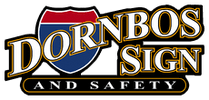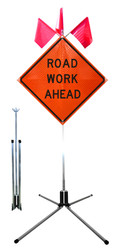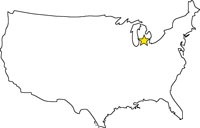Roll-Up Construction Signs │ The Importance of Having the Proper Signs for Road Closures
11th Dec 2017
Construction signs are important because they warn motorists of hazardous conditions ahead. The challenge for road and construction crews is to effectively post these signs for high visibility. This includes situations where driving at night and during inclement weather reduce visibility and pose an even greater hazard. Some of the most common uses for construction signs are:
- Road Closures
- Traffic Detours
- Construction Zones
- Slippery Under Wet Conditions
- Slides
- Breaks in Pavement
Some signs are made for daytime use only while others are reflective for visibility at night. Some instruct drivers to follow an alternate route due to current construction or other construction. Others warn drivers of hazardous conditions and the need to drive slower and/or more cautiously than normal. The variety of signs used by road and construction crews makes it especially difficult to provide the level of sign usage that ensures the greatest level of safety. Due to the bulk of traditional signs, signage is often kept to a minimum.
Roll-Up Construction Signs
Roll-up constructions signs improve visibility, portability, and the safety of all types of road conditions and worksites. The lighter weight materials used allow users to simply roll them up and take them from place to place. They are often made of mesh and they come in a wide range of styles. Since roll-up signs take up less space than traditional ones, it is easy to use more signs and deliver a number of messages to alert drivers to the conditions ahead.
Road crews spend a great deal of time bolting traditional constructions in place. They also spend time disassembling the signs once they finish the job. Roll-up construction signs come with a portable stand that takes far less time and energy to install and uninstall. Crews clean-up faster and easier, saving the owner time and money.
Customized Messaging with Overlays
Overlays make it easy to combine information is a single sign. For example, you could place an overlay on a Road Detour sign to point the direction drivers need to go. Other examples include directions to veer left or right. When the crew changes the location of the roadwork, just change the overlay to indicate which side of the road the construction is currently on. In many cases, overlays add to the roll-up sign’s visibility and prevent drivers from missing it altogether.
Better Portability=Better Performance
As of 2013, there were 4.07 million miles of paved roads in the United States. There is always a next job for construction crews who keep those roads safe for drivers. The faster they get their current job completed, the sooner the roads return to safe driving conditions. The time they save by using roll-up construction signs also allows them to get to the next job a little faster.
How Roll-Up Construction Signs Improve Safety
Construction site safety is important for the workers and drivers alike. It alerts drivers to hazardous conditions and to the presence of construction crews. The primary purpose of any construction sign is to create a safer environment. Roll-up construction signs accomplish this in a number of obvious and not-so-obvious ways.
- Improving Visibility
- Increase Signage Use
- More Specific Messaging
- Reflective and Non-Reflective Finish
- MUTCD, DOT, and NRHP Compliant
One MUTCD Standard requires roadside sign supports to be placed in a clear zone, to be breakaway, yielding, or shielded. Traditional construction signs fixed on wood or metal posts pose a hazard to drivers if they crash into them. The portable stands used to secure roll-up construction signs meet the standard for optimal safety with as little effort as possible.
Signs placed on wooden or steel posts are less visible if the post is not perfectly vertical. At the same time, placing too many posts behind a sign is a potential safety hazard. Roll-up signs remove this concern by offering even display without the need to break the surface of the ground.
Signs may fail to meet MUTCD Standards for a number of reasons. Those that reduce night-time visibility by failing to meet reflective levels are a major concern. The option to carry non-reflective signs for daytime use in addition to reflective signs for night time use increases compliance and safety.
Improved stability comes from cross-bracing fiberglass ribs. Corner pockets made from strong plastic give them greater durability. In spite of their lightweight, roll-up signs are tough enough to withstand the harshest weather conditions.
A More Versatile and Cost-Effective Method of Signage
The variety of styles, use of overlays, and options for customization brings you virtually unlimited choices in creating the perfect message in any situation. Higher visibility improves safety for your crew and for drivers. The portability of roll-up signs reduces the risk of vandalism since they roll-up and go with you when you finish the job. The signs aren’t left behind to be picked up by a second crew.
Roll-up construction signs come in a wide variety of standard messages. Build your inventory with those that you use most frequently. Always have the sign you need to warn drivers of a “road closure,” “road work ahead”, or “rough road ahead”. Use the overlays to make your message more specific such as “to the left,” “to the right,” or “double fine for speeding through the work zone ahead.” The more accurate your message is, the safer your work zone will be.
The strength of the materials used to construct these signs makes them durable and long-lasting under a wide range of conditions. They save you money by requiring less time to install and uninstall. They also cut costs of replacement by lasting longer to start with.
Three things matter most to construction crews: Safety, Time, and Money. Of these, safety is always the primary goal. Cutting corners to save time and money is never an option. The beauty of roll-up construction signs is that they help in all three areas. No matter how small or large the work site is, safe and compliant signage should always be your first consideration.




